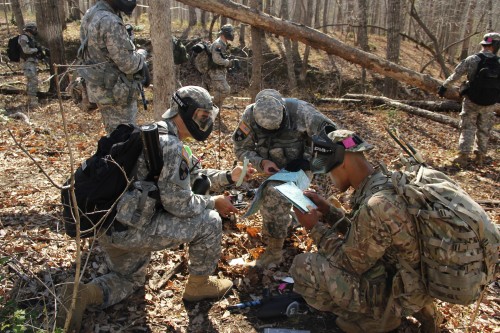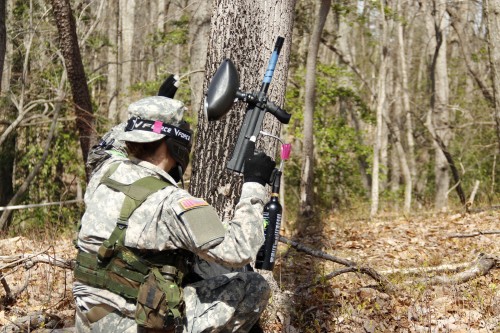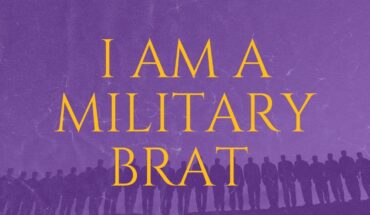This story was originally published in the April 18 issue of Fourth Estate.
There was a startled yelp to the left. A Mason cadet had fallen face-first into the marsh. With the help of his paintball gun, he struggled to his feet and kept moving.
Clad in head-to-toe camo, this platoon of Reserve Officers’ Training Corps (ROTC) cadets faced a difficult task — using a maze of logs and rocks to cross the marsh and cross it quickly, ideally without falling in like their unfortunate comrade.
The muck had caught them by surprise. The platoon expected a marsh, but its breadth and depth were impossible to anticipate. The acting sergeant of this platoon, a cadet from Georgetown University, urged his troops to keep a fast pace. Earlier that day, he told his men the key to success is swiftness in execution.
Sgt. 1st Class Diogenes Navarro disagreed. He compared the noise of the platoon to that of a troop of orcs running through the woods.
“This is basically what they’re doing right now. And that’s not a good thing,” he said.
They had sacrificed stealth, which could have proved disastrous in an actual combat situation. Fortunately, this marsh-crossing was just part of the annual Joint Leadership Development Exercise (JLDX), where ROTC cadets from Mason and other universities spend four days and three nights in the field at Fort AP Hill, near Bowling Green, Va., and run simulations of real-world scenarios.
Testing leadership

A cadet participates in a simulated military force-on-force exercise in the woods of Fort AP Hill. (Photos by Amy Rose/Fourth Estate)
From April 7-10, Mason’s Patriot Battalion joined with cadets from Howard University and the Hoya Battalion, which consists of American University, Georgetown University, George Washington University, the Catholic University of America and the Institute for World Politics. These cadets were placed together and tested on their leadership skills, physical training and military and strategic knowledge.
Cadets were graded on exercises in land navigation, military skills and force-on-force operations. Though they normally spend all day and all night in the field throughout the exercise, this year cold temperatures forced everyone to sleep in barracks.
Cadets have unique roles during each year of ROTC. A first-year cadet is called an MS1, a second-year is an MS2, a third-year is an MS3 and students in their fourth and final year are MS4s. Each year involves increasing leadership opportunities and expectations for growth.
The ROTC program aims not only to create future officers, but also to mold exceptional leaders. With each year in the program, cadets’ leadership responsibilities increase. This is especially true during JLDX.
MS4 cadets plan and execute JLDX. The universities participating in the exercise have been working to coordinate the transportation and education of nearly 300 cadets since November 2015.
Felix Camacho, Mason’s Patriot Battalion commander, emphasized how valuable this planning experience is for MS4 cadets.
“If you have a foundational tool, which is our planning process, then nine times out of ten you’ll be in a more advantageous position to succeed in any operation that we go in and do,” Camacho said. MS4s who have completed the ROTC program graduate as second lieutenant Army officers.
“It’s a great opportunity to access the cadets’ leadership skills and also give them a great experience,” Maj. Lucas Cottrell said.
Mason Cadet Rachel Sellers, an MS3, said the beauty of JLDX is that none of the MS3s are given their leadership assignments ahead of time.
“They want us to be able to think on our feet and step into those leadership positions and plan everything out and take the operation and perform it,” Sellers said. She also said JLDX is designed to prepare MS3s for the Cadet Leadership Course, a month-long training program in the summer, which includes staying in the field for 13 days.
“My personal goal was to be both a leader and a follower and understand the differences there. That way you can support other schools when they’re in the leadership positions,” explained MS3 Cadet Amanda Ambrogi.
JLDX not only tests cadets on their knowledge of the responsibilities of each leadership position or tactical maneuvers; there’s a huge emphasis on ensuring that cadets are able to think critically and adapt.
“For juniors, it’s how they make decisions. Especially under pressure and when things don’t go the way they think they do,” Cottrell said.
During exercises, it was clear that cadets sometimes struggled to bring the tactical knowledge into the field. Ambrogi noted the time cadets spend in the field is a new challenge that cannot be matched by classroom instruction.
Although JLDX is only simulated force-on-force, the implications of each exercise are felt by the cadets. Especially through the use of paintball guns, it is easy to see the impacts the leaders’ decisions have on their cadets. In combat simulations, cadets are armed with paintball guns and “go down” when they are hit.
At the end of each mission, MS3s in leadership positions are able to see the paint splatters on their comrades’ uniforms. Though these stains are nothing compared to the impacts of real combat, the simulation forces cadets to understand the importance of effective leadership in the field.
Cadet Jeremy Neff, an MS3, was excited for the opportunity to take part in leadership exercises.
“A lot of my decisions will decide how many people in my unit get hit or how many survive,” Neff said.
Upon arrival at JLDX, cadets are assigned leadership positions and expected to take on those responsibilities completely. These leadership positions are all within a company, a platoon or a squad. All cadets at JLDX were organized into a dingle company and this company was divided into three platoons. Leadership positions were assigned to the company as a whole, each platoon and each squad.
“As an MS3, you can be the squad leader for one rotation, and then all of a sudden you’re leading the entire platoon,” Neff said.
This is to ensure that cadets are prepared to step into any position in the field.
“If someone gets hit, you have to be able to take over their position,” Ambrogi explained.
Although the exercise focuses on providing leadership roles to MS3 cadets, JLDX also allows MS1 and MS2 cadets to hone the skills they have developed through their ROTC classes.
Cadet Michael Menkaus, an MS1, was excited to attend his first JLDX.
“I think that with experience like this, the best parts are the moments that, at the time, hurt the most,” Menkhaus said.
Above all, cadets of every year were excited to carry out tactical simulations, their fingers itching to grip a paintball gun.
First contact
At one point on its first mission, the Bravo 2 platoon stopped movement and the leading officers assembled to discuss new strategies. In the middle of this discussion, there was a stifled “Shit, there’s people on that trail!” from one of the cadets.
In an organized scramble, Bravo 2 got down, found cover and strained their eyes in search of movement between the trees. Another platoon dissolved out of the landscape, seemingly unaware of Bravo 2 hiding only a few hundred meters away. The other platoon was clad in black long-sleeved shirts, identifying them as enemy forces.
Success in the field depends on each platoon’s ability to act as a team. Everyone held fire and awaited instruction from their commander.
After four tense minutes, the distant figures were identified as friendly. The cadets rose from behind logs and under piles of leaves to resume their normal watch positions.
Only a few minutes later, paintballs were flying. The troops identified as friendly were in fact the enemy forces and they were now very much aware of Bravo 2’s presence.
Some cadets took cover behind scruffy bushes while braver souls ran in zig-zags between the trees. Those hit in the hips, legs or arms kept moving, but those who took paintballs to the head or chest were forced to lie down and play dead. After a few minutes, it was all over.
Field training
Mason was responsible for organizing force-on-force actions like these to provide cadets with hands-on tactic experience. In the first iteration on Saturday morning, cadets navigated their way to the initial starting locations, hiking through wood areas with surprisingly rough terrain. Pillows of leaves pooled in the steep ravines, making it difficult to keep footing on the steep hills. Initial neat blocks of cadets traveling six-by-six eventually broke up as people stepped over fallen trees and leaped over creek beds.
When in the field, each cadet must adjust to an alien environment. JLDX is an opportunity for cadets to get used to this acclimation process. At 6:53 in the morning, when most Mason students were fast asleep, the Patriot Battalion was establishing security at their new camp at Fort AP Hill.
Establishing security, as Captain Amanda Feindt explained, involved setting up guards 360 degrees around the camp’s location to ensure there were no enemies waiting in the surrounding landscape. After security is established, these guards remain in place until they receive orders from their commanding officers.

Cadets work on land navigation as part of their training during this year’s JLDX. MS3 cadets were given the task of leading their platoons to certain points in the woods.
Commanding officers are usually MS3 participants who have been assigned leadership positions. Company Commander, MS4 cadet Shepket Tohti, briefed the MS3 cadets on the mission. “The purpose of this operation is to free people from oppressive government and their forces as well as keep them from gaining territorial advantage,” Tohti explained.
The commander briefs cadets on terrain, mission goals, communication and other vital information. Platoon leaders then communicate to their respective platoons and coordinate specific tactics to put in place.
To train for this trip, cadets took part in weekly lab sessions to cover training for land navigation and tactical strategies. This practical learning extends JLDX over the entire school year to ensure cadets get the most value out of their time at Fort AP Hill.
The labs were organized into crawl, walk and run phases. Initial training took place in the RAC cage gym, then cadets transitioned into working on the intramural fields. These exercises prepared cadets for JLDX’s “running” phase.
One of the skill tests cadets must pass during JLDX is the Land Navigation Skills test. Cadets are armed with a map, a compass and a protractor and given specific geographical points to find. They must convert grid coordinates found on their maps and convert them to degrees in order to find their way using a compass. Howard University organized and facilitated this portion of training.
During this exercise, specific MS3 leaders were assigned in each platoon and given the opportunity to delegate tasks. Cadet Sheila Pierre, an MS4 cadet from Howard, said many of the groups were unable to find all of their given locations. Pierre emphasized that although not everyone was successful, all benefited from practicing land navigation in unfamiliar terrain.
Room to learn
Several cadre members and MS4 cadets tagged along with each platoon. MS4 cadet Courtney Gaines explained that MS3 leaders would be “evaluated by an MS4 who has been observing them and judging their performance.” After each mission, an After Action Review takes place, where platoons discuss what was supposed to happen versus what did happen and receive feedback from the MS4 cadets and cadre members who watched.
According to a cadre member of the Georgetown Battalion, one of the most valuable elements of JLDX is the room it gives cadets to make mistakes.
“Our intent was that subordinate leaders fail and understand that it is hard to command,” he said. “These failures help ensure that cadets fail less often when they are introduced to combat situations, and help leaders develop through adversity.”
Mentorship in ROTC
In addition to the formal roles of leadership in ROTC, there are many others of mentorship and camaraderie. Cadre Jasmine Tucker and MS4 Cadet Caitlin Carrington have known each other since Carrington’s first ROTC class her freshman year. On the long drive into the base, the two swapped stories, many of which involved shared experiences. They talked about long sweaty drills Tucker had put Carrington through and the excitement surrounding the upcoming military ball.
It was clear that all traces of unfamiliarity between the two had melted away long ago. When Carrington mentioned several of her friends, Tucker nodded, implying she had met them all before, and Tucker shared stories of her children and husband without restraint. A conversation that began with Tucker ragging on Carrington for freshman year mishaps turned into Tucker recognizing Carrington as “one of the great success stories we talk about.”
Other cadets also recognize their roles in mentoring other younger cadets through ROTC.
“It’s more than tactical proficiency. It’s, you know, helping the people around you get through college because we’re all students,” Ambrogi explained.
Hannel emphasized that mentorship is tied closely with leadership. According to him, every cadet is able to take their own experiences and failures and share them with their peers.
“I think mentorship is the best kind of formal and informal constructive criticism, and kind of leadership in general,” he said.
Cadet Gaines from Howard reflected that peer-to-peer interaction can make the biggest impact.
“It’s one thing when your commanding officers tell you to do something, but when your higher cadets say not to do something, it really makes it stick,” Gaines said.
Mikael Adisse, MS3 cadet, reflected on his own experiences with mentorship in the ROTC program. Adisse explained that Camacho’s previous experiences, both in-combat and in everyday life, play a big role in how he leads the cadets. “I felt blessed to have a mentor like him,” Adisse said.
Click through the gallery below to view more photos from JLDX. All photos by Photography Editor Amy Rose.
Correction: Originally, Cadet Shepket Tohti was incorrectly identified as an MS3; he is an MS4. The current article reflects this change.
(Read more: Food in the field: A look at Army rations from JLDX)























